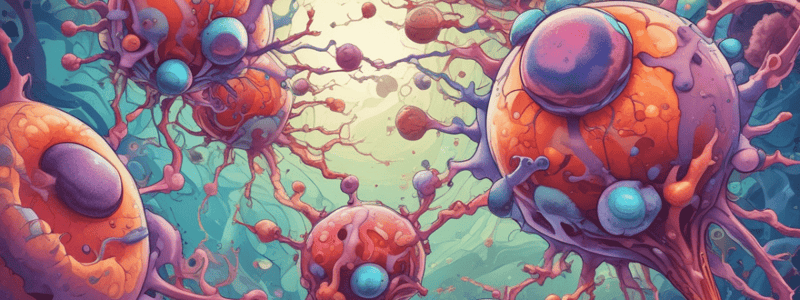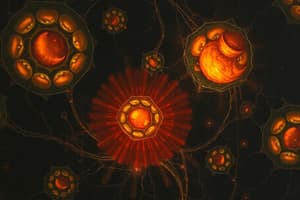Podcast
Questions and Answers
What is the primary function of apoptosis in response to excessive DNA damage?
What is the primary function of apoptosis in response to excessive DNA damage?
- To induce mutations in the DNA
- To increase cell proliferation
- To prevent the possible development of cancer (correct)
- To repair damaged DNA through NER pathway
What is the consequence of thymine dimers on DNA structure?
What is the consequence of thymine dimers on DNA structure?
- It disrupts DNA structure and interferes with accurate replication (correct)
- It has no effect on DNA structure
- It enhances DNA replication accuracy
- It increases DNA repair efficiency
What is the characteristic morphological change in cells during apoptosis?
What is the characteristic morphological change in cells during apoptosis?
- Cell size increases
- Nuclear envelope remains intact
- Cytoskeleton collapses and cell surface bulges (correct)
- Chromatin remains dispersed
What is the fate of apoptotic bodies?
What is the fate of apoptotic bodies?
What triggers the activation of caspases during apoptosis?
What triggers the activation of caspases during apoptosis?
What is the role of executor caspases in apoptosis?
What is the role of executor caspases in apoptosis?
What is the consequence of excessive DNA damage on skin keratinocytes?
What is the consequence of excessive DNA damage on skin keratinocytes?
What is the characteristic of apoptosis in terms of its duration?
What is the characteristic of apoptosis in terms of its duration?
What is the primary function of phosphatidylserine in the process of apoptosis?
What is the primary function of phosphatidylserine in the process of apoptosis?
Which of the following proteins is involved in blocking apoptosis?
Which of the following proteins is involved in blocking apoptosis?
What is the role of survival factors in apoptosis?
What is the role of survival factors in apoptosis?
What is the consequence of cells not receiving continuous signaling from survival factors?
What is the consequence of cells not receiving continuous signaling from survival factors?
What is the relevance of the apoptosis regulation mechanism in development?
What is the relevance of the apoptosis regulation mechanism in development?
What is the function of caspases in the process of apoptosis?
What is the function of caspases in the process of apoptosis?
What is the primary function of p53 in the intrinsic pathway to trigger apoptosis?
What is the primary function of p53 in the intrinsic pathway to trigger apoptosis?
What is the result of mitochondrial outer membrane permeabilization (MOMP)?
What is the result of mitochondrial outer membrane permeabilization (MOMP)?
What is the primary function of executioner caspases in the apoptosis process?
What is the primary function of executioner caspases in the apoptosis process?
What is the primary function of the apoptosome complex?
What is the primary function of the apoptosome complex?
What is the result of DNA fragmentation by CAD in the apoptosis process?
What is the result of DNA fragmentation by CAD in the apoptosis process?
What is the consequence of DNA damage in the intrinsic pathway to trigger apoptosis?
What is the consequence of DNA damage in the intrinsic pathway to trigger apoptosis?
What is the function of the death-inducing signalling complex (DISC) in apoptosis?
What is the function of the death-inducing signalling complex (DISC) in apoptosis?
What is the role of Bax and Bak in the intrinsic pathway to trigger apoptosis?
What is the role of Bax and Bak in the intrinsic pathway to trigger apoptosis?
What is the ultimate consequence of the intrinsic pathway to trigger apoptosis?
What is the ultimate consequence of the intrinsic pathway to trigger apoptosis?
What is the primary mechanism of apoptosis triggered by cytotoxic T-cells?
What is the primary mechanism of apoptosis triggered by cytotoxic T-cells?
What is the role of iCAD in the apoptosis process?
What is the role of iCAD in the apoptosis process?
What is the function of death receptors in the apoptosis process?
What is the function of death receptors in the apoptosis process?
What is the result of the activation of initiator caspases in the apoptosis process?
What is the result of the activation of initiator caspases in the apoptosis process?
What is the characteristic pattern of DNA fragmentation observed in apoptosis?
What is the characteristic pattern of DNA fragmentation observed in apoptosis?
What is the primary reason why apoptosis does not occur in necrosis?
What is the primary reason why apoptosis does not occur in necrosis?
Which of the following is NOT a characteristic of necrosis?
Which of the following is NOT a characteristic of necrosis?
What is the role of RIPK1/RIPK3 in necroptosis?
What is the role of RIPK1/RIPK3 in necroptosis?
What is the primary difference between necrosis and necroptosis?
What is the primary difference between necrosis and necroptosis?
What is the outcome of the phosphorylation of MLKL in necroptosis?
What is the outcome of the phosphorylation of MLKL in necroptosis?
What is the outcome of the binding of death ligands to death receptors in necroptosis?
What is the outcome of the binding of death ligands to death receptors in necroptosis?
Flashcards are hidden until you start studying
Study Notes
Role of Apoptosis in Removing Damaged Cells
- Apoptosis removes damaged cells to prevent cancer development
- Exposure to UVB (290-320nm) leads to thymine dimers, disrupting DNA structure and causing mutations
- Thymine dimers are usually repaired by the Nucleotide Excision Repair (NER) pathway
- If DNA damage is excessive, apoptosis removes the cell to prevent cancer development
Morphological Changes During Apoptosis
- Cells become smaller
- Cytoskeleton collapses
- Nuclear envelope disassembles
- Chromatin condenses and is fragmented
- Cell surface bulges (blebs)
- Cells break up into membrane-bound "apoptotic bodies"
- Apoptotic bodies are engulfed and destroyed by phagocytosis by macrophages
- Apoptosis is a rapid process, with few dead cells observed in tissue
Caspases – Intracellular Mediators of Apoptosis
- Caspases are a family of proteases that trigger a sequence of intracellular events during apoptosis
- Caspases are synthesized as inactive precursors that are activated by cleavage during apoptosis
- Initiator caspases are activated by dimerization and cleavage, then activate executor caspases
- Executor caspases activate all the changes in cell biology observed in apoptosis
DNA Fragmentation
- Executioner caspases activate a specific endonuclease, CAD, which fragments DNA into discrete chunks
- DNA fragmentation occurs between nucleosomes, resulting in a ladder of fragments
Extrinsic Pathway to Trigger Apoptosis
- Apoptosis can be triggered from outside the cell through activation of death receptors on the cell surface
- Binding of Fas ligand to the Fas receptor activates the caspase cascade
- Death receptors are part of the tumour necrosis factor (TNF) family of receptors
Intrinsic Pathway (Mitochondrial) to Trigger Apoptosis
- The intrinsic pathway is activated in response to DNA damage, detected via the p53 pathway
- p53 stimulates the aggregation of Bax and Bak in the mitochondrial membrane, leading to mitochondrial outer membrane permeabilization (MOMP) and cytochrome c release
- Cytochrome c binds to Apaf1 to form the apoptosome complex, which recruits initiator caspases and triggers the caspase cascade
Removal of Apoptotic Cell by Macrophage
- Cells undergoing apoptosis are detected and removed by phagocytosis
- Phosphatidylserine (PS) is flipped to the outer leaf of the membrane, which is detected and triggers phagocytosis
Survival Factors Block Apoptosis
- Some proteins, such as Bcl2, interfere with Bax/Bak aggregation and block apoptosis
- Most cells require continuous signaling by survival factors produced by neighboring cells that block apoptosis
- Survival factors bind to cell surface receptors, leading to the synthesis of Bcl2
Necrosis – Cell Death with Collateral Damage
- Necrosis occurs in response to a dramatic event, such as hypoxia, ischemia, high temperature, or chemical exposure
- Cells swell (oncosis) and the membrane becomes leaky and breaks, releasing contents and triggering an inflammatory response
Other Mechanisms of Cell Death: Necroptosis
- Necroptosis is a programmed form of necrosis that occurs through the binding of death ligand to death receptor
- The necroptosis pathway involves receptor interacting protein kinase 1 (RIPK1) and RIPK3, leading to the formation of an ion channel in the plasma membrane
- The cell then swells and breaks, resulting in cell death
Studying That Suits You
Use AI to generate personalized quizzes and flashcards to suit your learning preferences.




